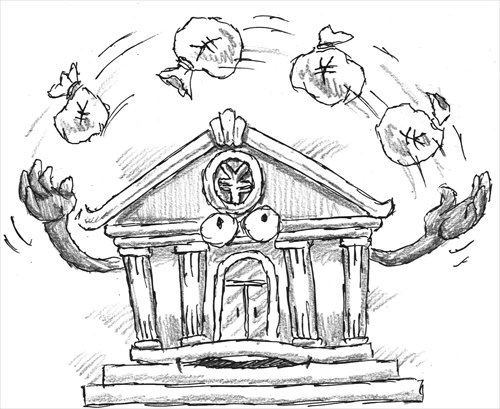China using quantitative measures, not QE
Central bank wary of excessive easing, credit expansion

Illustration: Peter C. Espina/GT
China is easing monetary policy with quantitative measures, as it has typically done in the past. However, this should not be regarded as the same as the quantitative easing (QE) programs undertaken by the US or the EU, a step they took after exhausting conventional methods of economic stimulus.
Unlike central banks in developed and many emerging markets, the People's Bank of China (PBC), China's central bank, relies mainly on quantitative means to manage its monetary policy.
Each year, the PBC sets a monetary aggregate (M2) target. To achieve this target, the central bank uses a range of methods that include on-lending facilities, open market operations and reserve requirement ratios to manage base money supply. In addition, the PBC also adopts additional means such as loan quotas and loan-deposit ratios to manage bank credit quantity.
The PBC has made some recent additions to its collateralized on-lending facilities, such as the medium-term lending facility (MLF) and pledged supplementary lending (PSL), which enable banks to lend money that they have borrowed from the central bank. These facilities have caused a great deal of confusion, with some likening the use particularly of PSL to Chinese-style QE.
In operating PSL, the central bank will provide liquidity to the China Development Bank (CDB) so that the policy bank can increase its lending to infrastructure projects and other government-supported investment. PSL was reportedly backed by collateral in the form of CDB loan assets in 2014, while in the future the collateral will likely be local government bonds.
It is also possible that commercial banks may in the future be able to use local government bonds as collateral to access on-lending facilities from the central bank.
But fundamentally, the use of PSL, among a variety of other on-lending facilities, is not materially different from how the PBC has managed China's base money supply in the past. The only difference is that the type of collateral used will now include new local government bonds once they are available, along with longer terms of liquidity provision.
A possible expansion of PSL does not mean that China has run out of other means to increase base money supply or that interest rate cuts are no longer effective.
The central bank could easily have cut the still high reserve requirement ratios more aggressively, but the government chose to use PSL and other similar liquidity facilities instead, due to a belief that PSL can deliver more targeted easing to fund infrastructure projects - other measures are seen more as general easing measures.
Interest rates can of course be further lowered too, but that won't have much impact on the quantity of credit or monetary aggregates, which are managed by quantitative targets and constraints in China.
With regard to the local government debt swap, the central bank's potential acceptance of local government bonds as collateral for its long-term liquidity provision facilities does not equate to a direct purchase of government debt by the PBC.
Although some may see this only as a technicality, this debt will actually continue to officially sit on local governments' balance sheets. To the Chinese government, it is important to differentiate between providing liquidity to local governments and assuming direct responsibility for local government debt. And this line will not be crossed any time soon.
The analogy of China's own version of QE also overstates the amount of easing in China.
While some people have criticized China for easing again instead of forcing through faster structural changes in the real economy, many investors believe that the central bank has been behind the curve with respect to monetary easing, resulting in a notable rise in real interest rates and a slowdown in base money growth.
Why hasn't the government eased more forcefully, especially as it appears to care about growth and reducing risks? Going forward, what could prompt the government to ease more?
The government has actually been reluctant to ease because it may have been concerned about expanding credit too rapidly and further aggravating China's already high leverage ratio. On top of that, there is a commonly held belief that reserve requirement ratio and interest rate cuts are "general" easing measures that could lead to more rapid credit expansion, even though this is not necessarily the case.
Looking ahead, additional economic data deterioration and pressures in the real economy are expected to trigger more monetary easing, which will be necessary to help contain financial risks in a slowing economy.
The author is chief China economist at UBS in Hong Kong. bizopinion@globaltimes.com.cn